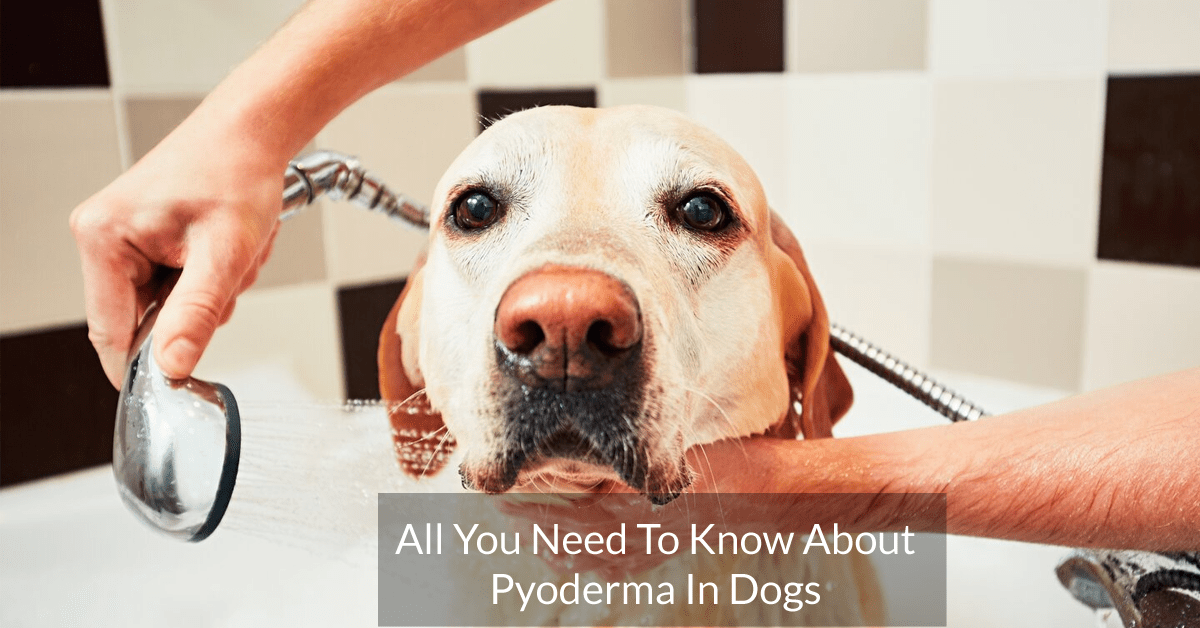Bacterial skin infection is one of the most commonly known skin problems in dogs. However, if left untreated, Pyoderma can spread, resulting in other skin conditions.
Pyoderma in dogs is one of the commonly known bacterial skin infections. The name pyoderma, in the literal sense, means pus in the skin. In young puppies, it is also called impetigo. It is a skin problem that can be superficial, like the hair follicles and epidermis or deep infections like an infection or any pathogenic organism that causes a skin infection.
Types of skin problems in dogs
There are two types of pyodermas infections, they are
-
Simple or one-time skin conditions such as flea infestations, ticks etc., with a tropical application or preventive measure. There can also be multiple treatment options like oral and topical medicines.
-
Complex or recurring infections can be due to underlying conditions or problems like internal diseases, allergies, seborrheic conditions, parasitic diseases, etc. These are solved with one or more one treatment options.
Understanding the clinical signs of Pyoderma in dogs.
If you notice slight redness or red patch on your dog, then seeking immediate help from a professional through MyFurries will be the right thing to do. The clinical signs of Pyoderma bacterial skin infections in dogs include
-
Small pimple like lesions on the skin called pustules or papules.
-
Flaky or dry patches of the skin
-
Itchiness of the skin
-
Patchy hair loss in the affected area.
Symptoms of Pyoderma in dogs
The similarities of the symptoms of Pyoderma in dogs are prevalent and are often misunderstood to various other skin conditions in dogs. The common symptoms of Pyoderma include
-
Puss or blood on skin
-
Crusting
-
Foul odour from the skin
-
Hair loss
-
Itching
-
Rash
-
Redness
-
Scaling
-
Touch sensitivity
-
Swelling
-
Ulcerated skin
-
Yellow papules
Bacterial skin infection in dogs and puppies – Causes
No doubt, any bacteria can cause bacterial skin infection in dogs and puppies; however, usually, the main reason behind the condition can be caused due to Staphylococcus intermedius bacteria. Certain disorders also trigger skin infection, such as
-
Allergic reaction
-
Autoimmune disorder
-
Immunosuppression
-
Physical damage to the skin
-
Warm, moist environments
Let us look at the possible cause of bacterial skin infections in dogs and puppies individually.
In Puppies
Puppy pyoderma is generally formed in the underarms and groin or any other area with thin hair growth. Some of the reasons behind the development of bacterial skin problems in dogs and puppies could include
-
Fungal skin infections
-
Yeast infections
-
Ticks and fleas
-
Thyroid problems or hormonal imbalance
It is also a side effect of certain medications like high doses of steroids, cyclosporine, azathioprine, etc.
In Big or Adult Dogs
-
Apart from the reasons mentioned above, the various causes of Pyoderma in dogs – adults in specific can be due to
-
It can be due to broken or chipped skin prone to or because of constant exposure to moisture such as playing in the water for a long time, constant biting of the paw or sitting in wet places for a long time.
-
It can also be due to injury, resulting in a moist environment prone to bacterial infections.
Booking an appointment with your vet through MyFurries will help you get a proper understanding of the reason or cause of the bacterial skin infections in puppies.
Diagnosis of Bacterial skin infection in dogs and puppies
To understand the cause of the bacterial skin infection and the treatment needed, you need to make an appointment with your vet through MyFurries. To provide the right course of treatment, the veterinarian will first do a proper examination of the affected area and ask you a few questions related to the pet’s health. Based on the information you provide and his/her professional diagnosis, the vet may either
-
Prescribe a topical application like cream or spray and/or oral medicines in the form of a liquid or tablet.
-
The vet may also conduct specific tests by taking a sample of the skin cells from the affected area.
-
Even a routine blood test may be considered to eliminate any underlying condition that can cause Pyoderma in dogs.
The actual course of treatment will be based on the test results that come in.
Bacterial skin infection in dogs and puppies – Treatment
Cleaning is one of the vital aspects while dealing with skin problems in dogs. Apart from medicines, sprays or creams, you may also be given a specific shampoo to help with your dogs’ skin infection. The vet will also let you know how many times you need to clean the affected area and the specific routine that you would need to follow. You can also follow MyFurries for more information regarding Pyoderma skin diseases in dogs.



